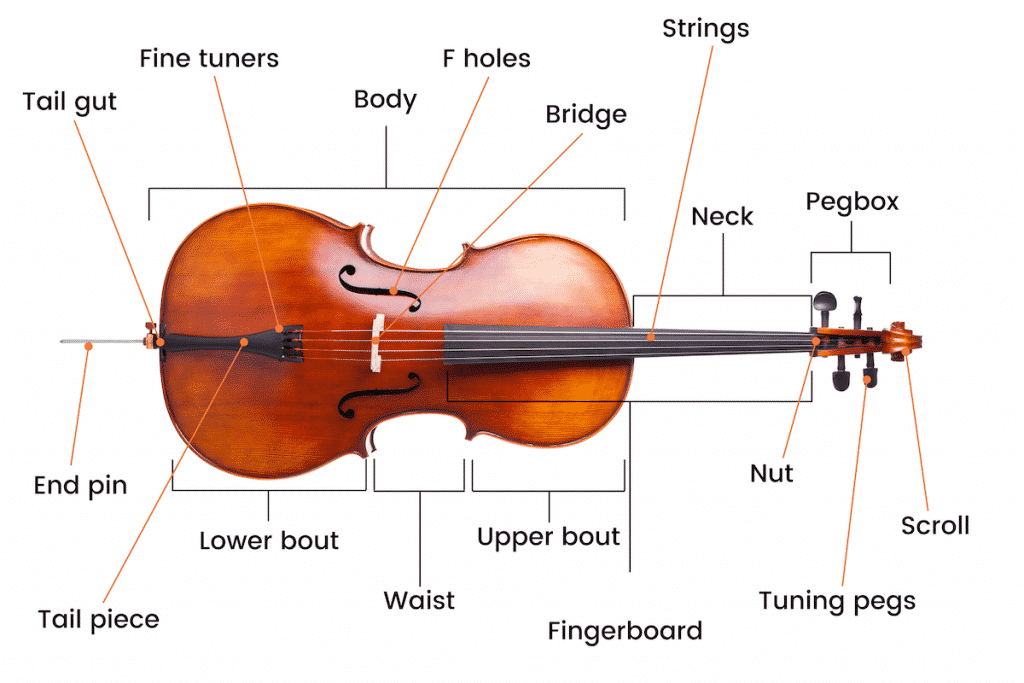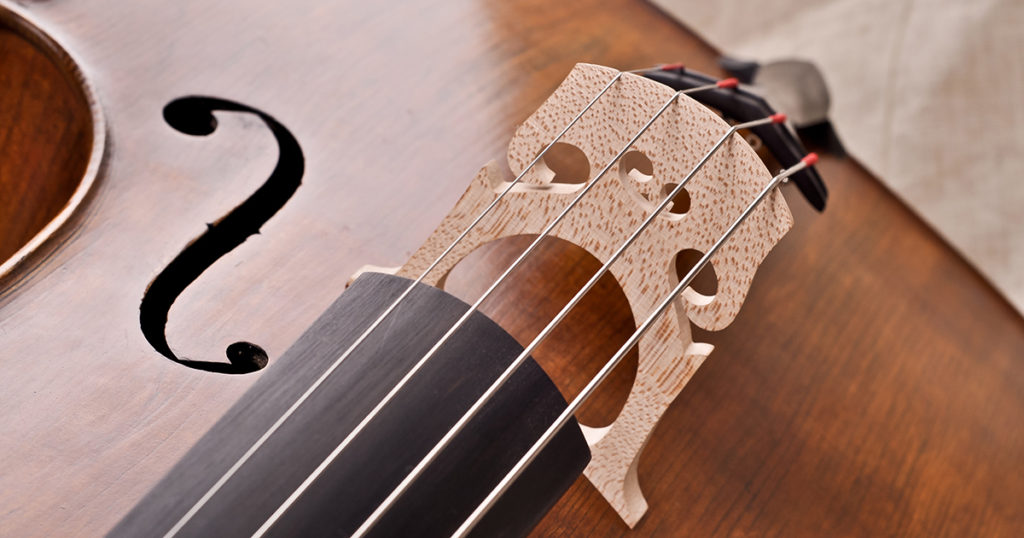About Tuning a Cello
Tuning a cello is a fundamental skill every cellist must master to produce beautiful and harmonious music. Whether you’re a beginner or an experienced player, this comprehensive guide will walk you through how to tune a cello. From understanding the cello’s anatomy to using the right tools, we’ve got you covered. Additionally, we will recommend some top-quality cello tuning products that will enhance your musical experience.
| Table of Contents | |
| 1 | The Anatomy of a Cello |
| 2 | Why Is Tuning Important? |
| 3 | Standard Cello Tuning: A440 |
| 4 | How to Tune a Cello: Step-by-Step Guide 4.1. Using a Digital Tuner 4.2. Tuning with a Pitch Pipe 4.3. Tuning with a Piano or Keyboard 4.4. Tuning by Ear |
| 5 | Tips and Techniques for Effective Cello Tuning 5.1. Maintaining Proper Peg and String Care 5.2. Understanding the Impact of Temperature and Humidity 5.3. Using Fine Tuners to Refine Your Pitch |
| 6 | Common Cello Tuning Problems and Solutions |
| 7 | Recommended Cello Tuning Products 7.1. Digital Tuners 7.2. Pitch Pipes 7.3. Cello Tuning Apps 7.4. Fine Tuners 7.5. Cello Peg Compound |
| 8 | Advanced Tuning Techniques for Experienced Cellists |
| 9 | Conclusion |
1. The Anatomy of a Cello
The cello is a bowed string instrument with a hollow wooden body, arched top, and back. It has a neck with a pegbox, and four strings running over a bridge to a tailpiece. Sound is produced by bowing or plucking the strings, and pitch is adjusted on the fingerboard. F-shaped sound holes on the top enhance resonance, creating the cello’s deep and warm tones.

2. Why Is Tuning Important?
Tuning is crucial in the cello to ensure accurate pitch and harmonious sound production. Tune your cello to ensure that each string is adjusted to the correct pitch, allowing the instrument to resonate in harmony with other instruments or ensembles. It contributes to the overall tonal quality and intonation of the cello, preventing dissonance and enhancing the musical experience. Accurate tuning is especially vital in ensemble settings to maintain cohesion and prevent discord.
3. Standard Cello Tuning: A440
Standard cello tuning is A440, meaning the A string is tuned to vibrate at 440 Hz. The other strings are tuned in perfect fifths relative to A, with D at 293.66 Hz, G at 196 Hz, and C at 130.81 Hz. This standard tuning allows for consistency across instruments, facilitating ensemble playing and ensuring harmonic coherence in musical performances.
4. How to Tune a Cello: Step-by-Step Guide
Follow our detailed step-by-step guide to tune your cello accurately. Learn different methods, including using a digital tuner, pitch pipe, piano, or keyboard, and tuning by ear.
4.1. Using a Digital Tuner
Using a digital tuner is a practical and efficient method for tuning a cello. Digital tuners detect the pitch of each string and display whether it is in tune. The tuner visually represents the pitch deviation, guiding the player to adjust the string tension until it aligns with the desired pitch, typically A440 for the A string. Digital tuners are accurate and convenient, especially for beginners, aiding in developing a precise ear for pitch. They are portable, allowing for easy tuning in various settings, making them a valuable tool for maintaining optimal pitch and enhancing the overall sound quality of the cello.
4.2 Tuning with a Pitch Pipe
If you want to tune your cello with a pitch pipe, it involves using a small device that produces a fixed pitch when blown into. The pitch pipe typically provides the reference pitch for the A string, which is traditionally set at A440 Hz. The musician blows into the pitch pipe to hear the A note and then tunes the other strings in perfect fifths relative to that pitch (D, G, and C).
While pitch pipes are a portable and straightforward tool, they may require a trained ear to match the pitch accurately. They offer a convenient tuning solution, especially in situations where electronic tuners or other tuning aids may not be available. However, for precise tuning and in professional settings, digital tuners or tuning forks are often preferred.
4.3. Tuning with a Piano or Keyboard
Tuning a cello with a piano or keyboard involves using the instrument as a reference to match pitches. Here’s a step-by-step process:
- Find the A Note:
- Locate the A key on the piano or keyboard. The standard tuning for the A string on the cello is A440 Hz.
- Play the A note on the piano.
- Tune the A String:
- Play the A string on the cello while listening to the A note on the piano.
- Adjust the tension of the A string until it matches the pitch of the A note on the piano.
- Use Perfect Fifths:
- Once the A string is in tune, use it as a reference to tune the other strings.
- Play the A and D strings together. Adjust the tension of the D string until it forms a perfect fifth with the A string.
- Repeat this process for the G and C strings, tuning them in perfect fifths with the adjacent strings.
- Check Intonation:
- Play various intervals and chords on the cello to ensure overall intonation.
Using a piano or keyboard provides a reliable and accurate reference for tuning each string. However, it’s important to note that pianos may be slightly out of tune themselves, so it’s a good idea to check the piano’s tuning before using it as a reference. Additionally, using an electronic tuner alongside the piano can further enhance accuracy.
4.4. Tuning by Ear
Tuning a cello by ear is a skill that relies on a musician’s ability to recognize and reproduce specific pitches accurately. Here’s a general guide for tuning a cello by ear:
- Reference Pitch:
- Start by obtaining a reference pitch for the A string. This can come from a reliable source, such as a tuning fork, pitch pipe, piano, or another instrument that is already in tune.
- Tune the A String:
- Play the A reference pitch and then pluck the A string on the cello.
- Adjust the tension of the A string peg until the pitch of the A string matches the reference pitch.
- Perfect Fifths:
- Once the A string is in tune, use it as a reference to tune the other strings.
- Play the A and D strings together. Adjust the tension of the D string until it forms a perfect fifth with the A string.
- Repeat this process for the G and C strings, tuning them in perfect fifths with the adjacent strings.
- Check Intonation:
- Play different intervals, scales, and chords to ensure overall intonation. Listen for any beats or dissonance and make fine adjustments as needed.
Tuning by ear requires a well-developed sense of pitch and may take time and practice to master. It’s advisable to regularly check the cello against a reliable reference, especially for beginners or in situations where precision is crucial. Additionally, using electronic tuners periodically can help refine the ear and ensure accurate tuning.
5. Tips and Techniques for Effective Cello Tuning
- Use a Reliable Reference:
- Start with a reliable reference pitch, whether it’s from a tuning fork, pitch pipe, piano, electronic tuner, or another instrument. A consistent reference ensures accurate tuning.
- Tune in Sequences:
- Tune one string at a time, starting with the A string. Once the A is in tune, use it as a reference to tune the D string, then the G, and finally the C. Tuning in sequence helps maintain overall stability.
- Perfect Fifths:
- Focus on creating perfect fifths between adjacent strings. After tuning the A string, use it as a reference to tune the D string, and so on. Consistent perfect fifths contribute to harmonious intonation.
- Check Double Stops and Chords:
- Play double stops (two strings played simultaneously) and chords to check the overall intonation. Listen for any beats or dissonance and make fine adjustments as needed.
- Use Harmonics:
- Utilize harmonics to check and refine the tuning. Natural harmonics can be produced by lightly touching the string at specific points while bowing. Harmonics can reveal discrepancies in pitch.
- Use Electronic Tuners as a Guide:
- While developing ear training, electronic tuners can serve as helpful guides. Use them periodically to check your tuning accuracy and to refine your ability to recognize pitch.
- Check Pegs and Fine Tuners:
- Ensure that pegs and fine tuners are functioning properly. Pegs should turn smoothly, and fine tuners should have enough range to make precise adjustments without running out of thread.
- Regular Maintenance:
- Keep your cello in good condition with regular maintenance. Check the condition of the strings, pegs, and fine tuners, and replace any components that show signs of wear.
6. Common Cello Tuning Problems and Solutions
- String Slipping or Unwinding:
- Problem: Strings slipping out of tune or unwinding from the pegs.
- Solution: Ensure that the strings are properly wound around the pegs, and use a moderate amount of pressure while turning the pegs. If the strings slip consistently, it may be time to replace them.
- Pegs Sticking:
- Problem: Pegs are difficult to turn or are sticking.
- Solution: Apply peg compound or peg drops to lubricate the pegs. If the pegs still stick, consider having a luthier address the issue.
- Fine Tuners Running Out of Adjustment:
- Problem: Fine tuners are unable to provide enough adjustment, and the pitch is still off.
- Solution: If using fine tuners, make sure they have enough thread for adjustment. If not, consider adjusting the pegs to bring the strings close to the desired pitch before using fine tuners.
- String Not Holding Pitch:
- Problem: The cello does not hold its tuning.
- Solution: Check for any issues with the pegs, fine tuners, or strings. Ensure that pegs are properly fitted, and consider using peg drops or compound. If the issue persists, consult with a luthier.
- Changing Weather Conditions:
- Problem: Strings frequently going out of tune due to changes in temperature or humidity.
- Solution: Keep the cello in a stable environment. If possible, use a humidifier in dry conditions and avoid exposing the instrument to extreme temperatures.
- Old or Worn Strings:
- Problem: Strings losing their elasticity and not holding pitch.
- Solution: Replace old or worn-out strings with new ones. Regularly inspect strings for signs of wear and replace them as needed.
- Bridge Misalignment:
- Problem: The bridge is not properly aligned, affecting string tension and intonation.
- Solution: Check the alignment of the bridge. If it is leaning or misaligned, carefully straighten it, or seek assistance from a luthier if needed.
7. Recommended Cello Tuning Products
Explore our carefully curated list of recommended cello-tuning products. From digital tuners and pitch pipes to cello tuning apps and fine tuners, these tools will help you achieve accurate tuning and enhance your playing experience.
8. Advanced Tuning Techniques for Experienced Cellists
For more experienced cellists seeking to refine their tuning skills, there are advanced techniques to explore. These techniques involve a deeper understanding of intonation and the ability to make micro-adjustments for optimal tuning. Some advanced cellists may experiment with alternate tunings or explore just intonation to achieve specific tonal qualities. Additionally, they may utilize electronic tuners with advanced features or even consider using smartphone apps that offer enhanced precision. By incorporating these advanced tuning techniques into their practice, experienced cellists can further elevate their musical expression.

Conclusion
Tuning a cello is an essential skill that every cellist must master. With our comprehensive guide, you now have a solid understanding of the step-by-step process to tune your cello accurately. From the anatomy of a cello to using various tuning methods, such as digital tuners and pitch pipes, we have provided you with the knowledge and tools to achieve perfect pitch.
Whether you’re a beginner or an experienced cellist, if you tune your cello with precision and care, you will unlock new levels of musical expression. So, grab your instrument, tune it up, and embark on a musical journey filled with melodious notes and enchanting performances.



